Types of Port Wine: An In-Depth Guide to Portugal’s Famous Drink
History of Port Wine
Origin and Historical Context
Have you ever wondered why Port wine has captivated palates and elevated occasions for centuries? The secret lies in its meticulously controlled production – a tradition that dates back to the 18th century. At the heart of this tale is Marquês de Pombal, a figure as rich and complex as the wine he helped preserve.
In 1756, the Marquis found himself during a growing crisis. Port wine, Portugal’s national treasure, was threatened due to widespread fraud and overproduction. His answer? A groundbreaking decision that restricted the region of Alto Douro Vinhateiro, thereby creating one of the world’s first regulated wine regions. This act gave birth to what we now understand as ‘appellation’ or ‘Designation of Origin,’ known in Portuguese as ‘Denominação de Origem Controlada.’ Henceforth, only wines produced and aged in this region, adhering to stringent quality standards, could proudly bear the name Port Wine.’
This wasn’t just about wine; it was about community. Pombal’s decision safeguarded not just the quality and reputation of Port Wine but also the livelihoods of the Douro’s local communities, shaping the world of wine as we know it today.
But let’s rewind the clock a bit. While the Douro region has been regulated for over two centuries, wine production there has ancient roots, predating even Roman occupation. This deep history has given rise to several styles of Ports Wine over the years, which we will explore in this guide.
How Port Wine Became Famous
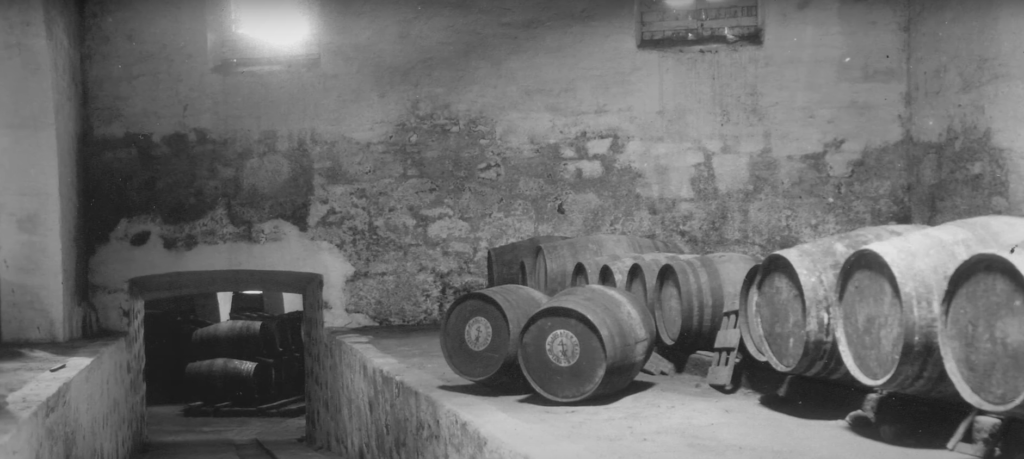
Step back within the historic Port wine cellars, where generations of winemaking craft are stored.
Fine wines have been an essential Portuguese export since the Kingdom of Portugal was established in 1174. As a southern European country near the Atlantic Ocean, sea trade with countries like England has historically been critical to the country’s economy. Although Portugal and England signed a political and commercial alliance, it was not until 1678 that written records began to appear that referred to wine from Portugal as “Port.” As English consumers developed a growing appetite for fine wine, their merchants delved deeper into the Douro River. They found several local wines that were far richer and full-bodied in flavor.
To preserve these wines on their journey back to Viana do Castelo, the commercial hub for the English merchants, the merchants came up with a brilliant solution. They would carry the wine down the Douro River to Oporto/Porto, a city directly connected to the Atlantic coast. From here, the new “Oporto” wines were loaded onto ships home to England. With time, the name “Oporto” was shortened to the simple “Port” as it is known today.
Many merchants often added brandy to the original “Oporto” wine to fortify it against the long sea journey. Although not all merchants supported the practice initially, many consumers became quick fans of the sweeter, more alcoholic wines with intense flavors that were capable of aging so well. Today, however, Port is fortified during the fermentation process for better alcohol integration.
The Role of Port Wine in Global Trade
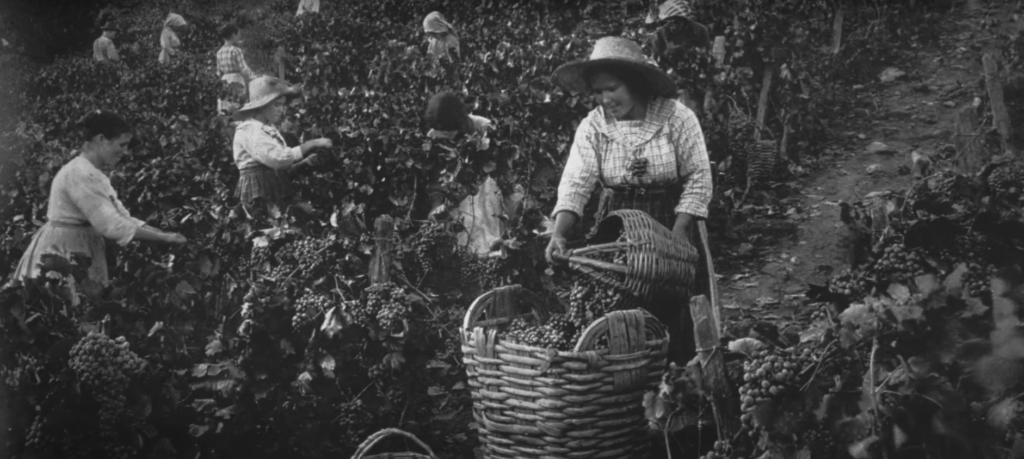
Capturing a moment in time, women laboring in the vineyards during the traditional Port wine grape harvest.
Peter Bearsley was an early English pioneer in the Douro wine trade and the son of the founder of Taylor’s. Bearsley is said to be the first English wine merchant to make the hazardous trip into the upper Douro in search of the best wines. By 1755, the Bearsly family were the first to buy vineyards and make their wine in the Douro, which gave them a great advantage.
Another important figure in the history of Port was the Marquis de Pombal, Portugal’s prime minister, who, in 1757, as mentioned previously, took strict measures to demarcate the Port vineyards according to their quality – creating an official Appellation. Those producing the finest wines were mainly for export and demanded higher prices known as ‘vinhos de feitoria.’ The wines for the home market were called ‘vinhos de ramo.’
The Douro Valley and Its Importance

A glimpse into the past with a traditional Rabelo boat sailing the Douro River, embodying Porto’s rich wine heritage.
The Douro Valley is Portugal’s beloved, winding, terraced region that produces the country’s precious port wine. Unlike the Rhine, Loire, and many of Europe’s great rivers, the Douro was never a strategic military location. So, many tourists and wine tasters would encounter sleepy villages and farms rather than castles and stony ramparts.
The Douro region stretches along the river of the same name, about 60 miles inland from Porto, where the Douro River spills into the Atlantic Ocean. The Douro Valley is the only place in the world to produce “port wine legally.” To this day, port production remains a labor of love, as grapes are still generally picked by hand and crushed traditionally — by foot — since machines cannot achieve high-quality results.
Since port wine is a blend of several types of grapes, most port-producing vineyards, called quintas, grow a few different varieties. More than 80 grape varieties grow in the Douro, with the lion’s share of the harvest set aside for the ruby, tawny, white, and rosé port wines that have made northern Portugal famous.
Types of Port Wine
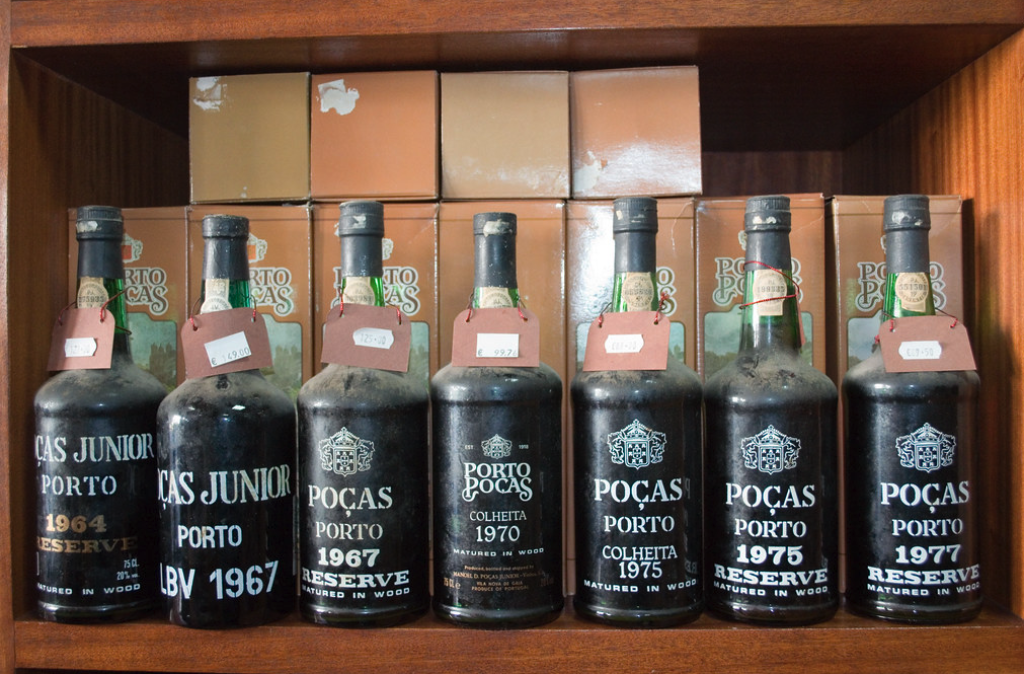
Explore the diversity of Port wine with this collection of bottles, each representing a unique style and vintage.
At first glance, you might see Port wine as a high-alcohol, sweet wine, but take a closer look, and you’ll discover a symphony of flavors and nuances, each a unique celebration of craftsmanship. With the alcohol content of Port generally ranging from 19% to 22%, Port wine is certainly not for the faint-hearted. Yet, it offers tempting sweetness and hues that can mesmerize even the most seasoned oenophiles.
The richness of Port wine is unparalleled, characterized by its intense fragrance that can fill a room as soon as the cork is popped. But it’s not just about the aroma; the flavors linger long after your glass is empty, a testament to the wine’s high persistence in scent, taste, sometimes fruity taste, and smooth finish.
However, what truly sets Port wine apart is its astonishing variety. Whether you’re captivated by the deep ruby shades or intrigued by its tawny counterparts, there’s a style of Port for every palate, occasion, and mood – there are even people that have, as a favorite dessert, a glass of Port. So get ready because we’re about to embark on a flavorful journey through the many types of Port wines that make this libation a timeless classic.
Ruby Port
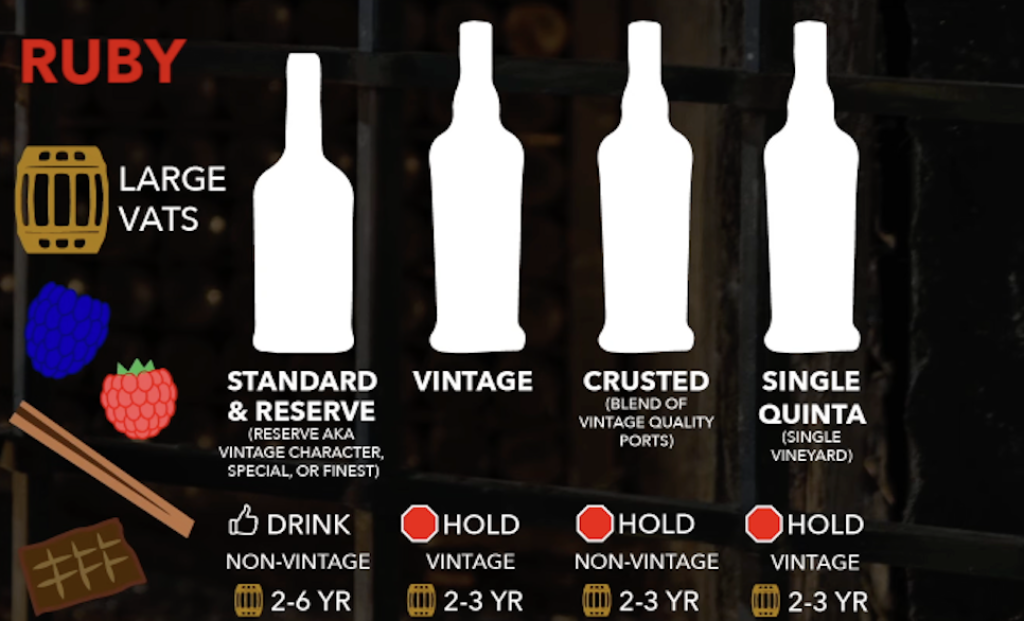
Explore the different types of Ruby Port, from Standard to LBV, and learn about their unique flavors and ideal pairings.
Just as a ruby gemstone captures the eye with its deep red allure, Ruby Port captivates the palate with its vibrant hue and full-bodied flavor. This isn’t your average red wine; it’s a masterful blend, a harmonious marriage of wines from various harvests crafted to enchant.
The Categories of Ruby Port, Ranked from Classic to Exquisite
Standard Ruby—Think of it as the introduction to the world of Ruby Port. It’s young, bursting with fruity aromas, and spends about three years maturing in wooden barrels. Once bottled, its flavors are set; it doesn’t evolve further but offers an immediate gratification of robust, fruit-forward notes.
Ruby Reserve—Now, if you’re wondering what the best port wine is, this is the right spot. Elevate your experience with this blend of the best Port wines crafted annually. It’s a full-bodied wine rich in color and flavor profile, intensely fruity yet surprisingly versatile.
Late Bottled Vintage (LBV)—A single-year masterpiece ages 4 to 6 years before bottling, LBV showcases the beauty of prolonged maturation. The color deepens, the tannins mellow, and slight oxidative notes emerge, creating a wine of exceptional character.
Crusted—Offering an affordable alternative to Vintage, this wine ages gracefully for three years in wooden barrels before bottling. It earns its name from the ‘crust’ or deposit it forms in the bottle, making decantation a must.
Vintage—also known as the classic vintage or single Quinta vintage Port – The crown jewel of Ruby Port. After two years in wooden barrels, this wine is bottled and left to mature. Shielded from air and light, its complex attributes unfold gradually like a blossoming flower. The label bears the harvest and bottling years, marking the wine’s life milestones. Exceptionally, some Vintage Ports come from a single estate or ‘Quinta.’ As time passes, a bottle of Vintage Port transforms. Its red hue softens, its aromatic complexity deepens, and its flavors gain nuance and harmony. The tannins and astringency are mellow, offering a taste experience that’s structured yet increasingly sophisticated. Over time, the wines even form a deposit, making decantation essential for an optimal tasting experience.
So, whether you’re a novice to the world of Port or a seasoned connoisseur, Ruby Port offers an enticing journey through varying styles, complexities, and maturation stages, each sips a celebration of winemaking excellence.
Tawny Port
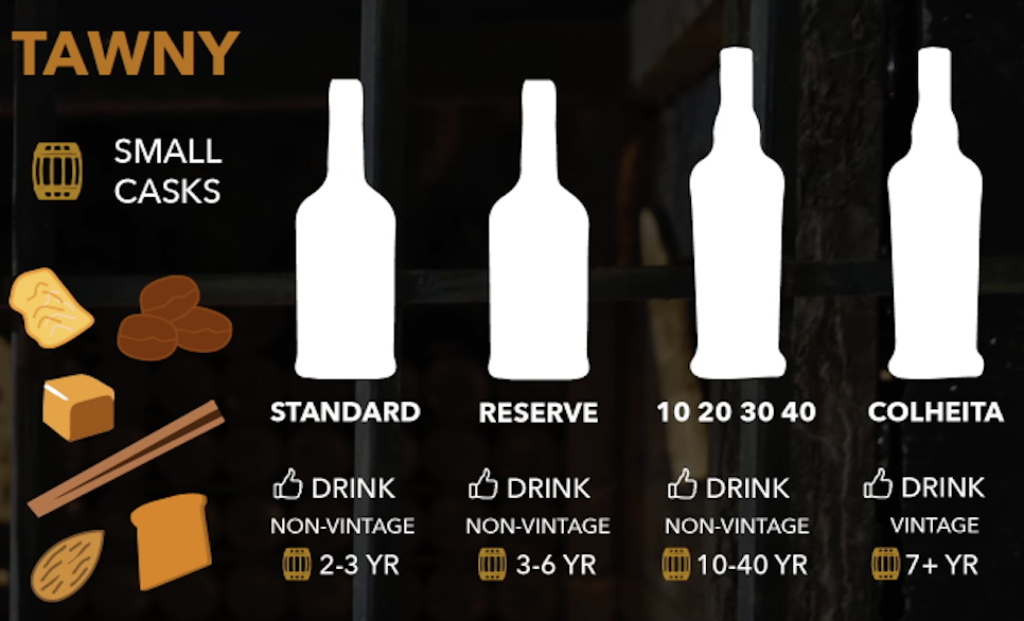
Discover the rich and complex world of Tawny Port, including its extended aging process and culinary versatility.
The golden allure of the best Tawny Port wine invites you into a complex world of aged-style wines, where time and wood play pivotal roles. Unlike its Ruby counterpart, Tawny wine matures more rapidly, its color, flavor, and alcohol content evolving in oak barrels to create a sumptuous tapestry of taste. Imagine the captivating scent of nuts and wood becoming more profound with age, all set against a backdrop that evolves from vibrant orange to the elegance of gold.
Unraveling the Tiers of Tawny Drink
Classic Tawny—Typically the result of blending wines from multiple harvests, these entry-level Tawnies offer an affordable introduction to this wine style. Aged for three years in oak barrels, their color can be described as ‘pale garnet,’ and youthful hints of nuts and wood dominate their taste profile.
Tawny Reserve—A sophisticated blend of older wines, Tawny Reserve combines the vibrancy of youth with the wisdom of age. It boasts a captivating amber hue and a superb balance between fruitiness and maturity.
Age-Designated Tawny—These Tawnies wear their age like a badge of honor. They are available in 10, 20, 30, and even 40-year designations. Interestingly, the average age of the blend often exceeds the period stated on the label, providing a richer experience than you might expect.
Colheita—These are the soloists in the Tawny symphony—a single-vintage Tawny ready to be savored upon bottling. Aged in wood for at least seven years, their color spectrum ranges from golden-red to tawny. As they mature, their complex notes of nuts and wood gain richness and depth.
As Tawny ages, its aromas and flavors transform. The palate experiences an explosion of elegant sensations, each sip revealing varying layers of richness, all influenced by the wine’s age and unique character.
So, next time you reach for a bottle of Tawny Port, remember you’re not just savoring a wine but embracing an age-old tradition that celebrates the artistry of time, wood, and unparalleled craftsmanship.
White Port

Explore the elegant and versatile world of White Port, from dry to sweet styles, and how to best enjoy them.
White Ports offer an entirely different universe of complexity, often overshadowed by its more famous counterparts. Crafted exclusively from white grape varieties—such as Malvasia Fina, Donzelinho, Gouveio, Codega, and Rabigato—this Port style represents an intricate tapestry of flavors blended with artful precision.
White Port offers a delightful range of sweetness levels, from the lusciously sweet Lágrima to Doce, Meio Seco, Seco, and the bone-dry Extra Seco. There’s even a unique category, Leve Seco, which has a lower 16.5% alcohol content and offers an incredibly dry profile.
Understanding Categories by Sweetness:
Dry White—This is the most dehydrated form of White Port, containing a maximum of 65 g/liter of residual sugar.
Standard White—A versatile option containing up to 130 g/liter of sugar.
Lágrima—The sweetest of the bunch, Lágrima surpasses 130 g/liter, delivering a rich, almost syrupy experience.
Indicated Age White—This harmonious, full-bodied blend of various wines with a similar average age provides a refined and mature experience.
White Colheita—This single-harvest White Port ages in large casks and emerges with a straw-colored hue, accompanied by elegant, mature aromas and flavors of fruit and wood.
White Ports, particularly younger styles, captivate the palate with vibrant fruity aromas, accented by hints of oak from the aging process. The next time you reach for a bottle of Port, consider the underrated elegance of a White. With its varied sweetness levels and nuanced flavors, White Port presents a luxurious world awaiting exploration.
Rose Port Wines
Rosé Port is the avant-garde expression in the storied world of Port wines, and its introduction was nothing short of polarizing. Traditionalists initially questioned its legitimacy within the Port wine spectrum, but this innovative variant quickly charmed its way into the hearts of new and seasoned wine lovers.
Crafted primarily from the same esteemed red grape varietals used in traditional Port wines, Rosé Port is a subtle study. What sets it apart is its unique color extraction process. In some instances, the captivating rose hue is achieved through gentle pressing, while in others, a brief period of skin contact—known as light maceration—suffices.
Far from aging in wood, which would influence its light and crisp character, Rosé Port is nurtured in stainless steel tanks. This preserves its innate freshness and minimizes oxidation, allowing the wine to maintain its vibrant, ruby-tinged rosé color.
When tasting notes, expect an alluring blend of fruity nuances, silky textures, and a soft, inviting palate. Its lightness and versatility make it exceptionally food-friendly, ideal as an aperitif or even a casual refreshment.
Temperature plays a crucial role in enjoying Rosé Port. To fully appreciate its subtlety and grace, serve it slightly chilled, ideally between 6-7°C (43-45°F). Presented in a tall glass over ice, it is an exquisite and refreshing experience.
Despite its fresh appeal, it’s worth noting that Rosé Port does not benefit from aging in the bottle. It is designed to be savored in its youth, capturing the zeitgeist of modern wine consumption while paying homage to the time-honored traditions of Port wine craftsmanship.
How Port Wine Is Made
Port Grapes
The Douro Valley in Portugal is divided into three broad areas: Baixo Corgo, Cima Corgo, and Douro Superior. As a rule of thumb in the Douro, the further east the region lies, the drier the climate becomes and the more concentrated the wines.
Douro Valley’s wealth of traditional grape varieties is one of its attributes. Although around thirty grape varieties can be used to make port, most modern vineyards in the Douro Valley use a selection of just five top red grapes, which are now generally considered to produce the finest wines: Touriga Nacional, Tinta Baroca, Tinta Cao, Tinta Roriz and Touriga Franca.
Aging and Maturation
The traditional manufacturing process includes interrupting the fermentation of the must by adding wine spirit, stocking, and aging. Amid its maturing process, wine is submitted to quality control tests, both analytical and sensory, carried out by the Laboratories and Board of Tutors of the Port Wine Institute, one of the oldest and most renowned public entities in Portugal.
Port is stable after the brandy is added but still needs development time. All Port wines must be aged for at least two years before release. Even then, it’s illegal for a Port producer to sell more than 30% of their vintage. Port wine producers are legally “encouraged” to age their wines for extended periods.
Aging Port in large oak balseiros or steel containers maintains Port’s initial winey (or ‘vinus’) flavor. Aging in smaller oak barrels called ‘pipas’ makes Port taste nuttier. The Pipas do this by increasing the amount of oxygen exposure to the wine. Winemakers rotate their wines to achieve their ideal balance of character. Typically, all Tawny Ports go through prolonged periods of aging in pipas.
The Role of Barrels
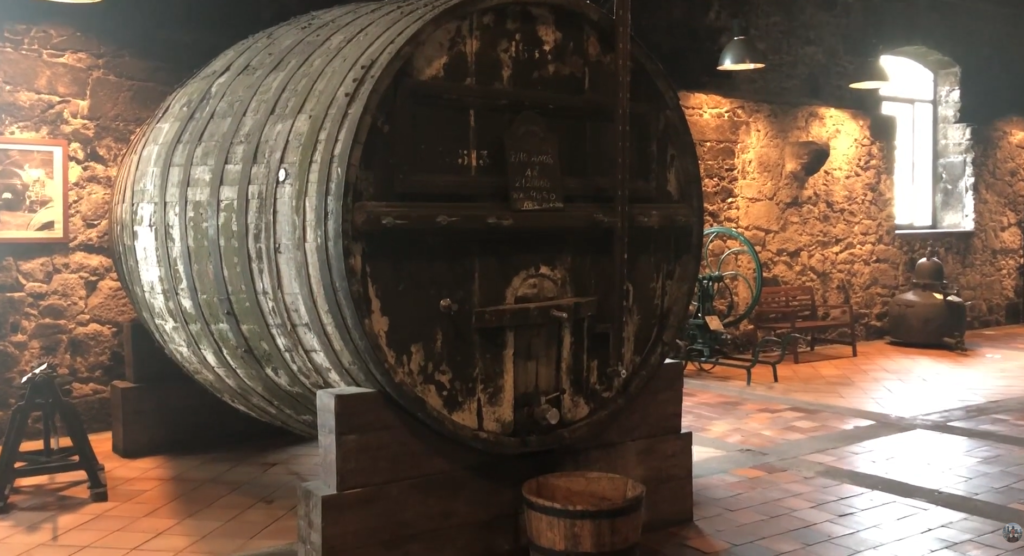
This giant wooden barrel showcases the traditional method of aging fine wines and spirits.
During the port-making process, Wood-aged Ports are aged in contact with oxygen in small, seasoned oak barrels (pipes) or larger, seasoned oak vats. The life cycle of a wood-aged port lies in the capable hands of the Master Blender and Cellar Master. Their job is to create blends from previously aged wines, interpret the wine’s future evolution, and set aside specific lots to age for subsequent generations. Thus, they elongate a wood-aged Port wine’s life history and origin.
How to Taste Port Wine
The Importance of Glassware
The importance of glassware when tasting wine can never be overstated. It would not be an exaggeration to say that the glassware is as important as the drink. The choice of glass can significantly affect the overall tasting experience, impacting the wine’s aromas, flavors, and presentation.
Port dessert wine glasses are generally smaller so that when you swirl, you scrap much of the alcohol, making it easier to appreciate the aromas. Port glasses tend to have a small stem, which is essential because it keeps your warm hand off the bowl where the wine is.
If you need clarification, please use tulip-shaped or slightly flared bowl glass. This shape is often recommended for fortified wines like Port because it captures and concentrates the wine’s aromas while allowing you to appreciate its richness and complexity.
Tasting Steps: Look, Smell, Taste
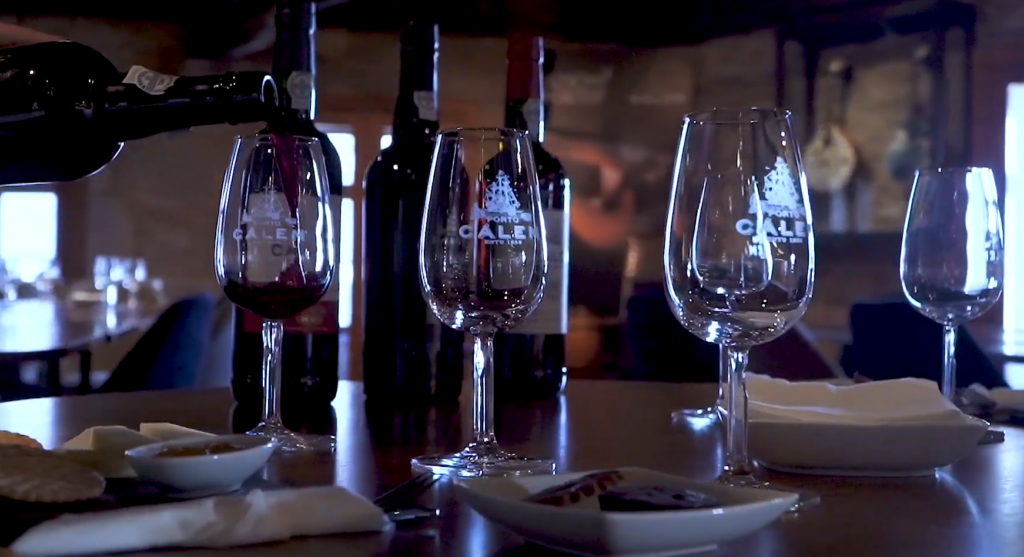
Experience the tradition of Port wine with expertly filled glasses, ready to be enjoyed.
Step 1—Appearance
The appearance of a wine speaks volumes about its origin and quality. This is also called the tint of the wine. To check the tint, hold the wine against a white background, like a napkin or tablecloth, to observe its intensity and color. A red wine that has not been aged will carry a deeper purplish color, while aged wines will lose their dark coloring and look like a paler red. The color also speaks about the type of grapes used for making the wine. For instance, Pinot Noir is the lightest.
Step 2—Bouquet
Next, check the bouquet or the smell of the wine. Swirl the wine in your glass once again to allow its smell to spread in the air. Once the wine settles in the mirror, take a complete sniff. Focus on the smell coming from your wine glass. If the wine is young, it will generally have a fruity scent. For instance, they can have notes of citrus or raspberry. If the wine is older, it will have a more profound, earthy smell, like grass or oak.
Step 3—Taste of the Wine
Now that it’s finally time to taste your wine, remember that you don’t feel most of the flavor of the wine through your tongue. Swish it around your mouth and then swallow it while focusing on the sensation and taste from the back of your throat. Also, while checking its taste, take a gentle slurp to allow all the flavors of the wine to get into your mouth.
Think about its body and weight. It can be thin and light or heavy and rich. Focus on the taste and consider whether it will go with your food. Remember that the flavors of the wine take some time to reveal themselves after the wine gets out of the bottle, and the same will happen when you drink it.
Decanting: When and Why
Vintage Ports only spend two years in wood casks before being bottled unfiltered. As the wine ages, sediments settle in the bottle over time. It would be best if you decanted a vintage Port so there’s no deposit when serving it. Decanting Port helps the sediment to settle down so you can thoroughly enjoy your drink. Additionally, younger Vintage Port wines develop a fuller body when left in a glass decanter. Decanting Port also opens the aroma and flavor of the wine.
Common Tasting Notes
All Ports are sweet, but depending on how long they have been aged and the grapes used in their production, the wine can evoke many shades of sweetness. Port is a full-bodied, medium-tannin dessert wine with notes of ripe, musky berries like raspberry and blackberry, bitter chocolate, and buttery, nutty caramel. Older posts contain concentrated notes of dried fruit, while younger ports taste lighter-bodied red fruits, like strawberries. The typical Port wine alcohol percentage is around 18-21% alcohol by volume.
Food Pairing with Port Wine
White Port is a remarkably versatile beverage for food pairing, with its multiple sweetness levels and complex flavor profiles offering a broad range of options. Whether planning a sumptuous dinner or simply indulging in a casual snack, there’s a White Port to elevate the experience. Here’s how to create the perfect pairings:
The Sweeter Side
Lágrima and Doces—These are your go-to choices for decadent desserts and cheeses. Think blue cheese, creamy cheesecakes, or even crème brûlée. The wine’s sweetness complements the food’s richness without overwhelming it.
In-Between
Meios Secos—These semi-sweet White Ports are incredibly versatile. They make an excellent match for dishes that contain sweetness and saltiness, like prosciutto-wrapped melon or a savory-sweet apple tart.
The Drier End:
Secos and Extra Secos—These wines excel when paired with seafood, particularly shellfish like oysters and clams. Their dryness and often crisp acidity cut through the saltiness of the seafood, creating a harmonious balance.
Leve Seco—Given its arid nature, this Port pairs excellently with light appetizers and salads. Its low alcohol content and crispness allow it to shine without overpowering the food.
Ruby Ports are best enjoyed at moderate temperatures and make excellent companions to various cheeses—think Sierra, Azeitão, and Cheddar. They also pair remarkably well with bitter chocolate and coffee-infused pastries.
Tawny Porto wine complements everything from strong cheddar cheeses to sumptuous desserts like apple pie, dried fruits, chocolates, cheesecake, and tiramisu. For optimal enjoyment, serve it at a temperature close to 15°C, a setting that allows the wine’s intricate flavors to shine without the overpowering influence of alcohol.
Cheese Pairings
Your choice of cheese has a lot to do with the kind of Port you’re drinking. Port’s rich, sweet, and fortified character complements various cheeses, creating a harmonious tasting experience. Here are our recommendations:
Tawny Ports—Try salty, dry, hard cheeses like aged gouda, cheddar, and parmesan. These cheese varieties balance the wine’s mellow, rich, and nutty flavors. With its nutty profile, Manchego, a Spanish sheep’s milk cheese, beautifully complements the Tawny Port’s flavor.
Vintage Ports—Choose a robust cheese that can withstand the strength of this remarkable wine. A creamy blue cheese like gorgonzola or an extra-sharp cheddar can match the wine’s chocolate, spice, and fruit.
White Port—This wine’s dry and slightly nutty characteristics make it an excellent choice to pair with a cheese, like gruyère. Gruyère has a smooth and slightly firm texture that melts beautifully when it encounters warmth.
Ruby Port—These ports are known for their vibrant red fruit flavors, which make them a natural match for cheeses with bold, tangy, and fruity profiles. Stilton, a rich and creamy blue cheese, contrasts the fruity notes in Ruby Port.
Dessert Pairings
Port varieties offer a complex and nuanced taste—an experience of a lifetime. Although each port is a dessert on its own, it can be paired with various desserts to enhance the experience.
White Port—White Port pairs wonderfully with summery desserts. Think fresh fruit compote, strawberry shortcake, peaches and cream, lemon bars, and freshly made sorbets at the end of a meal. If you’re feeling adventurous, pair your White Port with honey-drizzled baklava or a creamy panna cotta topped with caramelized figs.
Tawny Port—To enhance your Tawny Port experience, pair it with nut-based desserts. Think of traditional holiday offerings like pecan pie, pumpkin pie, or a cheesecake swirled with caramel. An almond biscotti alongside a glass of Tawny Port is a culinary masterpiece.
Ruby Port—Serve your Ruby Port with a pastry featuring tart fruit like sour cherry pie, rhubarb cobbler, white chocolate-covered strawberries, or chocolate ganache mousse. Fresh berry tart or cherry clafoutis is particularly delightful with Ruby Port.
Meat and Port Wine
Smoky or spicy meats pair well with Port wine. Port’s sweet and fortified nature complements many hearts’ richness and savory qualities. Here are some of our recommendations:
Tawny Port—Roasted meats like lamb, pork, or beef pair fantastically with Tawny Ports. Their nutty and caramelized flavors complement the savory richness of the meats.
Vintage Port—If you’re seeking a wine to complement hearty and robust meats, Vintage Port is your go-to choice. This wine’s intense tannins and concentrated fruitiness are tailor-made for beef steaks, venison, or game meats.
White Port—White Port provides a delightful contrast to poultry dishes. The dry versions pair nicely with succulent roast chicken. On the other hand, the sweet White Port is a charming match for honey-glazed ham or pork roast.
Ruby Port—With its lively profile, Ruby Port is a culinary match with meats served with tangy sauces. Try Ruby Port with succulent duck with a tantalizing cherry sauce. The vibrant fruitiness of Ruby Port is sure to amplify the dish’s flavors.
Rosé Port—Pair Rosé Port with lighter meats to add a touch of elegance to your weekend dinners. Grilled chicken, tender pork tenderloin, or some delectable seafood go very well with this wine.
Vegan and Vegetarian Options
Nuts and dried fruits pair deliciously with Port Wine for those considering vegan and vegetarian options. Almonds, walnuts, and hazelnuts all go well, and dried fruits like apricots, figs, and dates complement Port’s sweet, complex flavors. For a light snack, you can go right with dark chocolate or fruit-based desserts.
Suppose you want something more filling. Order fragrant and creamy Vegan Thai Green Curry, bursting with sweet, spicy, and savory notes, harmonizing with the refreshing and slightly sweet White Port. On the contrary, a classic Mushroom Stroganoff with earthy mushroom flavors and creamy sauce aligns seamlessly with the nutty and caramelized nuances of Tawny Port. Finally, a serving of Vegan Black Bean Burgers, paired with avocado, salsa, and fresh greens, pairs amazingly with the fruity vibrancy of Ruby Port.
Join The Avant-Garde Community
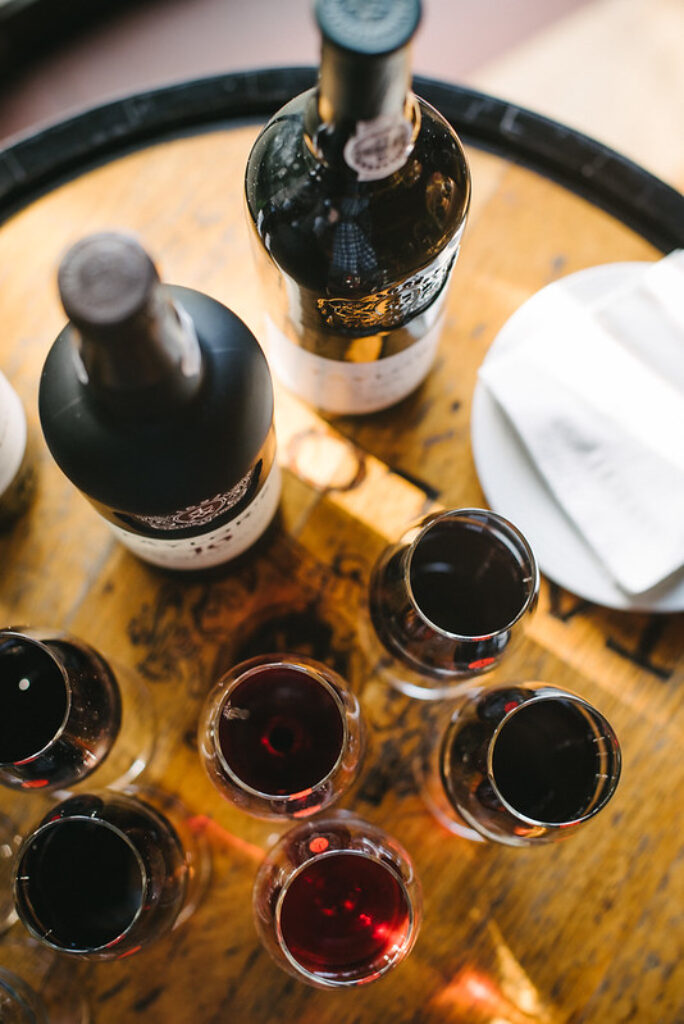
An elegant arrangement of Port wine bottles and glasses, viewed from above, ready for a tasting experience.
And with this, we come to an end of our journey.
We took a deep dive and covered:
- History of Port,
- Types of Port Wine,
- How Port Wine is Made
- How To Taste Port Wine
- Food Pairings with Port Wine
From A to Z, we have learned all there is about the Port Wines.
Join the Avant-Garde Community for more authentic travel and food guides. We make it easy for you to explore new cities around Portugal. Let us plan your bespoke trip while you sit back and relax, free from the hassle of putting everything together independently.
FAQ/TL;DR
What is Port Wine?
In the realm of wine drink names, vinho do Porto stands out. Port wine is a fortified Portuguese wine produced in the Douro River Valley of Northern Portugal. It is typically a sweet red wine served with dessert, although it also comes in dry, semi-dry, and white varieties.
Where is Port Wine from?
Port wine is produced in the Douro Valley of Northern Portugal.
Why is Port wine called Port?
Port wine received its name from the sea city of Porto, located at the mouth of the Douro River. It was sold at local markets and exported to England and other European countries.
What is the difference between wine and Port?
Port wine is typically richer, sweeter, heavier, and higher in alcohol content than other unfortified wines. Distilled grape spirits fortify Port wines and halt fermentation before all the sugar is converted to alcohol. This results in wine, usually 19% to 20% alcohol.
What is Port wine fortified with?
Port wine is fortified with unaged brandy before fermentation to yield a product with around 20% ABV.
What are the differences between fortified and unfortified wine?
Fortified wines have distilled spirits added during winemaking and are higher in alcohol than unfortified wines. No additional alcohol is added to unfortified wines.
What does Port Wine Taste Like?
Each port has its delicate taste. Common Tawny Port Wine flavors include citrus peel, roasted nuts, baked apples, and apricots. Rosé Port, meanwhile, offers much stronger berry flavors. On the other hand, Sweet White Port is lusciously sweet, often showcasing flavors of honey, dried fruits, and apricots. With Vintage Port, you can expect dark fruit flavors, such as blackberry, black cherry, and plum, alongside hints of spices like black pepper and sometimes a touch of cocoa or chocolate.
Is Port wine sweet?
Yes, Port wines are sweet. Due to their sweetness and aromatic body, they are often called’ dessert wines’.
How is Port wine made?
Port is a Portuguese fortified wine made by adding distilled grape spirit, usually brandy, to a wine base. The high alcohol content stops fermentation and “fortifies” the wine.
How long does the Port last open?
When stored in cool and dark conditions, Ruby and basic Tawny Ports last 4 – 6 weeks after opening. Ideally, you should finish a Ruby Port within the month, while a Tawny Port should be completed within two months of being opened.
What Are the Styles of Port?
There are many different styles of Ports:
Ruby Port: The least expensive and most produced style of Port. It is stored in stainless steel or concrete tanks, which minimizes contact with oxygen compared to wood vessels and preserves its ruby-red color.
Rosé Port: Rosé Port, which only entered the market just over a decade ago, is made in a way similar to traditional rosé wine. It has minimal exposure to grape skins, which gives it a pink hue.
Tawny Port: This is made from wine aged in wooden barrels. The wood contact allows both evaporation and oxidation, which changes the color of the wines. They appear rusty or tawny rather than bright red. Oxidation also introduces secondary, nutty flavors to these wines.
White Port: This is made solely from white grapes and can be found in dry, off-dry, and sweet styles. It’s often used in Portugal in a famous Port Tonic cocktail with white Port, tonic water, and a citrus twist. Vintage Ports: These are the most expensive and sought-after styles. The wines must be aged in barrels and bottled two to three years after harvest. These wines can age up to 40 to 50 years before they are ready to be thoroughly enjoyed.
What is Tawny Port wine?
Tawny Port is a fortified wine full of decadent flavors—caramel, peanut brittle, apricot, plum, raisin, and walnut—all knit harmoniously together.
What is the difference between Port and Tawny Port?
In contrast to the fruity, powerful Vintage Port, Tawny Port offers more subtle flavors like caramel, peanut brittle, dried fruits, nutmeg, chocolate, and walnuts. In contrast to Vintage Port, Tawny is aged before you buy it and is meant to be kept from being cellared further.
What temperature should you serve Port?
Most Ports are best served slightly below modern room temperature, i.e., 16° to 18° Celsius (or 61º to 64º Fahrenheit). If your wine is too excellent, it will not release all its aromas or flavors. However, if the wine is too warm, it may appear unbalanced or slightly spirited on the nose.
Is Port a dessert wine?
Yes, Port is a dessert wine, often enjoyed before or after desserts.
What are the leading houses of Port Wine?
Graham’s—Known for its exceptional vintage ports and a range of aged tawny ports. Graham’s enjoys a high reputation for quality and consistency.
Taylor’s—One of the oldest Port houses, Taylor’s is renowned for producing Vintage Ports that are rich and robust. Their LBVs and Tawnies are also highly regarded.
Fonseca—Another esteemed name in the industry, Fonseca is Known for its luscious and fruity Vintage Ports. It is also known for its organic and biodynamic viticulture practices.
Dow’s—Famous for its Vintage Ports, particularly the legendary Dow’s 1977 Vintage Port. They also produce a variety of other styles, including Tawnies and LBVs.
Sandeman—Recognized by its iconic caped logo, Sandeman is known for a wide range of Port styles, from aged Tawnies to robust Vintage Ports.
Niepoort—A smaller house but well-respected, especially for their Colheitas and other Tawny Ports. They also produce noteworthy Vintage Ports.
Warre’s—One of the oldest British Port companies, Warre’s is mainly known for its Vintage Ports and Warrior Reserve, a premium Ruby Port.
Croft—Established in 1588, Croft is known for their Tawny and Ruby Ports and is one of the leaders in the production of Rosé Port.
Quinta do Noval—Famous for its Nacional Vintage Ports, which are produced from a small ungrafted vineyard. They also make excellent Tawnies and LBVs.
Ramos Pinto—Known for its Tawny Port wine brands, especially the 30-year and 40-year Tawnies, which are highly praised for their complexity and elegance.
Most of these Port cellars can be visited in Vila Nova de Gaia, where you can try a colheita port, crusted port, reserve port, and many more.











